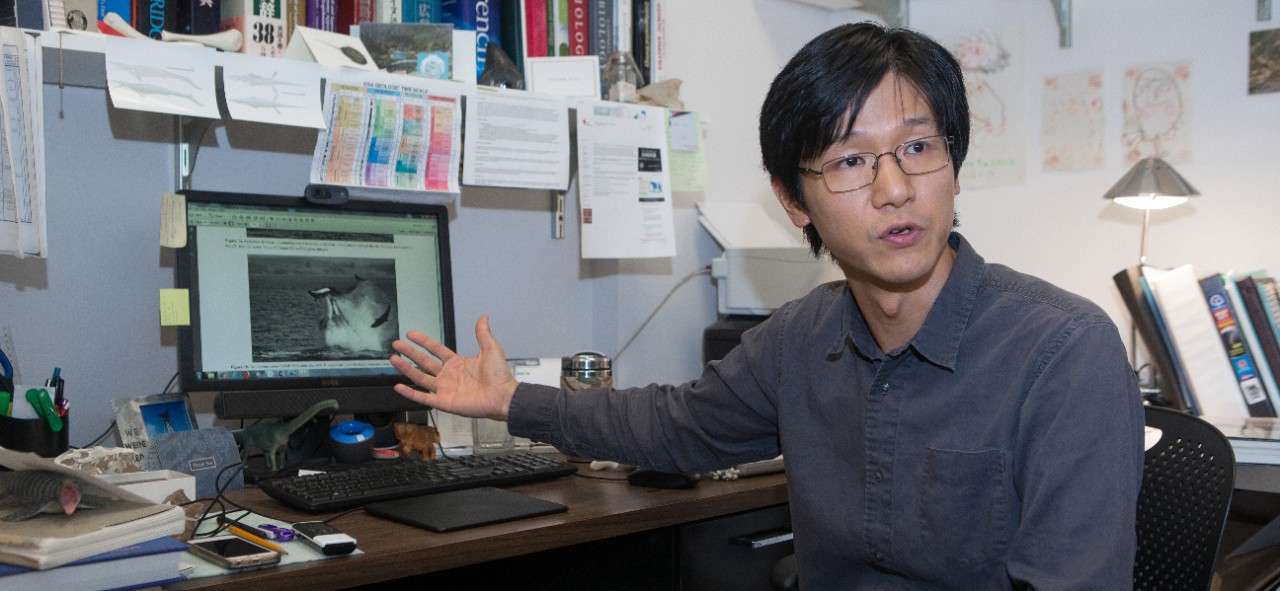
UC mosasaur research attracts international attention
Smithsonian, BBC, FOX News highlight UC biology professor Takuya Konishi's new study on 'ugly duckling' of ancient marine reptiles
International news media highlighted research by University of Cincinnati biology professor Takuya Konishi, who will present his findings at this month's Society of Vertebrate Paleontology conference.
The study demonstrates the value UC places on research in its strategic direction, Next Lives Here.
Konishi theorizes that some prehistoric sea creatures called mosasaurs might have subdued their prey by ramming them with their bony snouts like killer whales do today.
In a study published this month in the Journal of Vertebrate Paleontology, Konishi examined skull fragments of a baby mosasaur found in Kansas in 1991 and used his experience and other fossil examples to identify it as a Tylosaurus, the largest known mosasaur species. Unlike other species, Tylosaurus had a protruding bony snout. But the baby's snout was blunted and not nearly as prominent.
Konishi speculated that this feature, called a rostrum, becomes more pronounced as the marine reptile ages. He likened it to the "ugly duckling" that grows into the graceful swan, a notion that caught on with BBC News, which called it the "ugly duckling fossil from the deep."
Smithsonian Magazine called it "a case of mistaken sea monster identity."
FOX News called the discovery an "85 million-year-old sea monster."
United Press International, or UPI, quoted UC's Konishi on his moment of discovery when he realized what he was looking at.
"Having looked at the specimen in 2004 for the first time myself, it took me nearly 10 years to think out of that box and realize what it was – a baby Tylosaurus yet to develop that snout," Konishi said.
Europa Press in Madrid, Spain, highlighted the discovery of the smallest baby mosasaur ever found.
Read more about his discovery in UC News.
Featured photo above: UC biology professor Takuya Konishi talks about the aggressive hunting behavior of orcas. Photo/Joseph Fuqua II/UC Creative Services.

A mosasaur skull. Photo/Ravenna Rutledge/UC Creative Services
Next Lives Here
The University of Cincinnati is classified as a Research I institution by the Carnegie Commission, and is ranked in the National Science Foundation's top 35 public research universities. UC's graduate students and faculty investigate problems and innovate solutions with real-world impact. Next Lives Here.
Related Stories
What's behind the mysterious rise of migraines?
January 5, 2026
Weather patterns such as extreme heat and storm conditions have been linked to migraine attacks, and research shows those environmental conditions are becoming more common. As National Geographic recently reported, one of the leading theories behind this mysterious rise is that climate change may be playing a role.
Top six 2025 nephrology drug approvals
January 5, 2026
“2025 has been a landmark year for kidney disease therapeutics, marked by a comprehensive slate of FDA approvals covering endothelin-receptor blockade, complement inhibition, GLP-1-based metabolic protection, and B-cell-directed therapy,” Prakash Gudsoorkar, MD, associate professor of clinical medicine at the University of Cincinnati College of Medicine and staff nephrologist at UC Health, recently told MedCentral.
Weight loss drugs help, but not on their own
January 5, 2026
Millions of Americans are on one type of weight loss drug or another, and a University of Cincinnati physician says there are things to know as we enter the new year. Malti Vij, MD, adjunct associate professor in the Department of Internal Medicine and provider at UC Health Primary Care in Mason, recently spoke to 91.7 WVXU News.
